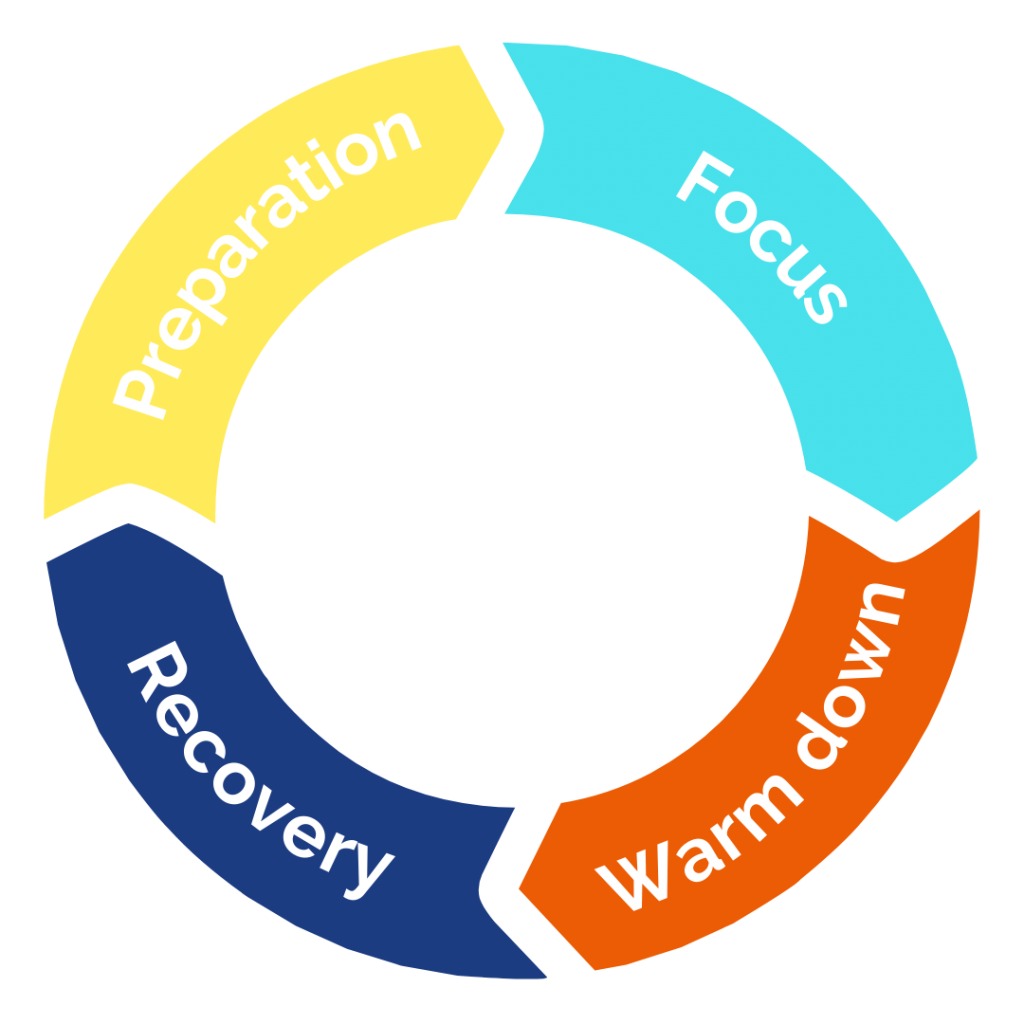By using highperformanceroutines.com, you agree to our Cookie Policy.
High Performance Routines
High Performance Routines

THE CONCEPT
High Performance Routines
The High Performance Routines (HPR) concept is acknowledged as a cutting-edge and evidence-based response to the challenges of the 21st century workplace, in particular the flat line way of working.
HPRs help people to work in a more focused, sustainable and human way, which is more in sync with our bodies’ natural rhythms.
Research suggests that people become happier, healthier and higher performing by following the 4 stages of a HPR: Preparation, Focus, Warm down and Recovery.

THE CONCEPT
High Performance Routines
The High Performance Routines (HPR) concept is acknowledged as a cutting-edge and evidence-based response to the challenges of the 21st century workplace, in particular the flat line way of working.
HPRs help people to work in a more focused, sustainable and human way, which is more in sync with our bodies’ natural rhythms.
Research suggests that people become happier, healthier and higher performing by following the 4 stages of a HPR: Preparation, Focus, Warm down and Recovery.

THE CONCEPT
High Performance Routines
The High Performance Routines (HPR) concept is acknowledged as a cutting-edge and evidence-based response to the challenges of the 21st century workplace, in particular the flat line way of working.
HPRs help people to work in a more focused, sustainable and human way, which is more in sync with our bodies’ natural rhythms.
Research suggests that people become happier, healthier and higher performing by following the 4 stages of a HPR: Preparation, Focus, Warm down and Recovery.
Why 4 stages?
Most elite performers follow a routine, which enables them to perform at a high level sustainably.
In general, there are 4 stages to any High Performance Routine:

The first stage is
Preparation
The next stage is
Focus
Next comes
Warm down
Finally
Recovery
Think about an athlete preparing to play in a big match, or a musician readying themselves for a performance.
This is the stage where performers perform – usually with high levels of intensity, focus and purpose.
Think of an athlete warming down after the intensity of performance.
is seen as part of an elite performer’s job. A necessarily prelude before the cycle begins again.




These 4 stages have been shown to drive sustainable high performance.
Why 4 stages?
Most elite performers follow a routine, which enables them to perform at a high level sustainably.
In general, there are 4 stages to any high performance routine:

The first stage is
Preparation
Think about an athlete preparing to play in a big match, or a musician readying themselves for a performance.
The next stage is
Focus
This is the stage where performers perform - usually with high levels of intensity, focus and purpose.
Next comes
Warm down
Think of an athlete warming down after the intensity of performance
Finally
Recovery
is seen as part of an elite performer’s job. A necessarily prelude before the cycle begins again
These 4 stages have been shown to drive sustainable high performance.
Why 4 stages?
Most elite performers follow a routine, which enables them to perform at a high level sustainably.
In general, there are 4 stages to any high performance routine:
The first stage is
Preparation
Think about an athlete preparing to play in a big match, or a musician readying themselves for a performance.
The next stage is
Focus
This is the stage where performers perform - usually with high levels of intensity, focus and purpose.
Next comes
Warm down
Think of an athlete warming down after the intensity of performance
Finally
Recovery
is seen as part of an elite performer’s job. A necessarily prelude before the cycle begins again
These 4 stages have been shown to drive sustainable high performance.
How the 4 stages work together
In a high performance routine one stage supports the next.
For example, by Preparing well, people are far better able to Focus.
With better Focus, people feel a greater sense of permission to Warm down and consciously switch off.
This in turn creates better Recovery, which enables the whole process to start again.

How the 4 stages work together
In a High Performance Routine one stage supports the next.
For example, by Preparing well, people are far better able to Focus.

With better Focus, people feel a greater sense of permission to Warm down and consciously switch off.
This in turn creates better Recovery, which enables the whole process to start again.
How it works
In a high performance routine one stage supports the next.
For example, by Preparing well, people are far better able to Focus.
With better Focus, people feel a greater sense of permission to Warm down and consciously switch off.
This in turn creates better Recovery, which enables the whole process to start again.

How to work like an athlete
Prepare
The purpose of the Preparation phase is to:
- Mentally prepare
- Narrow focus and build clarity of what ‘good’ looks like.
Without a Preparation phase, it is easy to feel reactive – pushed onto the back foot from the first moment of the day. This makes us feel less in control of our day, and more stressed.
The benefits of a Preparation phase are therefore about a greater sense of control and purpose, which assists calm, clarity and focus.
Even 10 minutes per day of extra Preparation time have been shown to enhance feelings of control and improve overall outcomes.
For preparation strategies, try the preparation tools pdf here
Focus
The purpose of the ‘Focus’ phase is to protect some part of the day for deeper, more concentrated work.
The Focus phase can be difficult to protect, particularly in job roles that require high levels of reactivity.
Nevertheless, protecting some time each day to think more deeply enables greater efficiency and higher quality outcomes, irrespective of task.
Without a Focus phase, people often feel like they are busy but not productive.
Even 25 minutes per day of extra Focus time could increase the impact you make on your most important priorities, leading to a greater sense of satisfaction and achievement.
For focus strategies, try the focus tools pdf here
Warm down
The purpose of a ‘Warm down’ phase is to intentionally transition away from work and to enable a strong recovery process.
The benefits of a Warm down routine include lower anxiety and reductions in the work / life blur.
This helps to optimise the Recovery stage that follows.
Warm down also includes pre-sleep routines which include intentional rituals taken immediately prior to sleep.
By strengthening the Warm down, you are likely to increase your ability to switch off effectively at the end of the day which will help to optimise your recovery (and sleep).
For warm down strategies, try the warm down tools pdf here
Recover
The purpose of the ‘Recovery’ phase is to regain energy, but an underrated feature of recovery is the ability to gain a better perspective on your thoughts, emotions and challenges.
This stage is also where you are most likely to have a good idea or insight and progress an idea subconsciously.
The benefits of a strong recovery routine are therefore more than just better wellbeing; better Recovery leads to clearer thinking, better insights and better decision making.
A strong daily Recovery routine is the foundation of sustainable high performance. As any athlete will tell you, there is no ‘performance’ without recovery.
For recovery strategies, try the recovery tools pdf here
How to work like an athlete
Prepare
The purpose of the Preparation phase is to:
- Mentally prepare
- Narrow focus and build clarity of what ‘good’ looks like.
Without a Preparation phase, it is easy to feel reactive – pushed onto the back foot from the first moment of the day. This makes us feel less in control of our day, and more stressed.
The benefits of a Preparation phase are therefore about a greater sense of control and purpose, which assists calm, clarity and focus.
Even 10 minutes per day of extra Preparation time have been shown to enhance feelings of control and improve overall outcomes.
For preparation strategies, try the preparation tools pdf here
Focus
The purpose of the ‘Focus’ phase is to protect some part of the day for deeper, more concentrated work.
The Focus phase can be difficult to protect, particularly in job roles that require high levels of reactivity.
Nevertheless, protecting some time each day to think more deeply enables greater efficiency and higher quality outcomes, irrespective of task.
Without a Focus phase, people often feel like they are busy but not productive.
Even 25 minutes per day of extra Focus time could increase the impact you make on your most important priorities, leading to a greater sense of satisfaction and achievement.
For focus strategies, try the focus tools pdf here
Warm down
The purpose of a ‘Warm down’ phase is to intentionally transition away from work and to enable a strong recovery process.
The benefits of a Warm down routine include lower anxiety and reductions in the work / life blur.
This helps to optimise the Recovery stage that follows.
Warm down also includes pre-sleep routines which include intentional rituals taken immediately prior to sleep.
By strengthening the Warm down, you are likely to increase your ability to switch off effectively at the end of the day which will help to optimise your recovery (and sleep).
For warm down strategies, try the warm down tools pdf here
Recover
The purpose of the ‘Recovery’ phase is to regain energy, but an underrated feature of recovery is the ability to gain a better perspective on your thoughts, emotions and challenges.
This stage is also where you are most likely to have a good idea or insight and progress an idea subconsciously.
The benefits of a strong recovery routine are therefore more than just better wellbeing; better Recovery leads to clearer thinking, better insights and better decision making.
A strong daily Recovery routine is the foundation of sustainable high performance. As any athlete will tell you, there is no ‘performance’ without recovery.
For recovery strategies, try the recovery tools pdf here


